Buffalo New York
USS Little Rock – Buffalo Naval Park
A love-lorn lonely male sprit likes to follow living women around the ship, hoping.
Another spectral sailor is mischievous.
Auditory sounds give clues of spectral whereabouts.
Spirits are not shy about showing themselves as they go about their business.
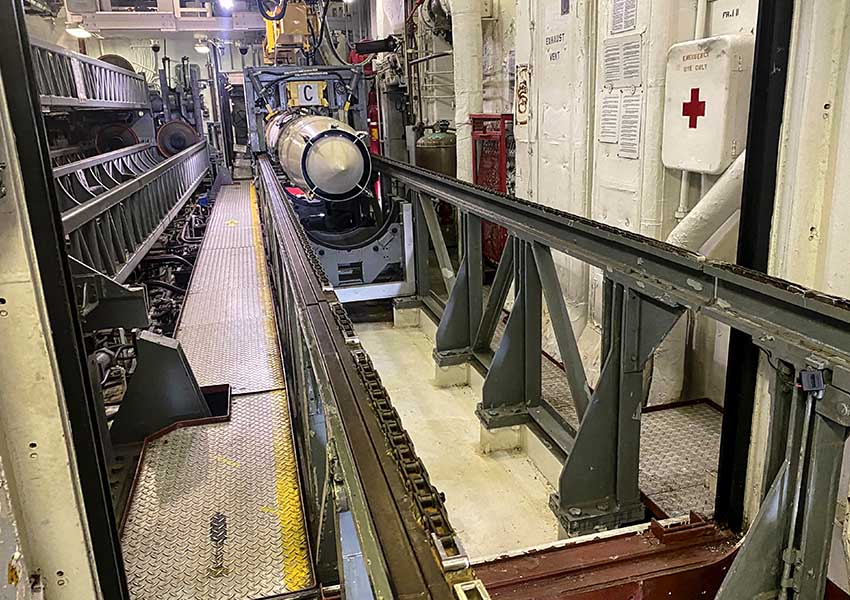
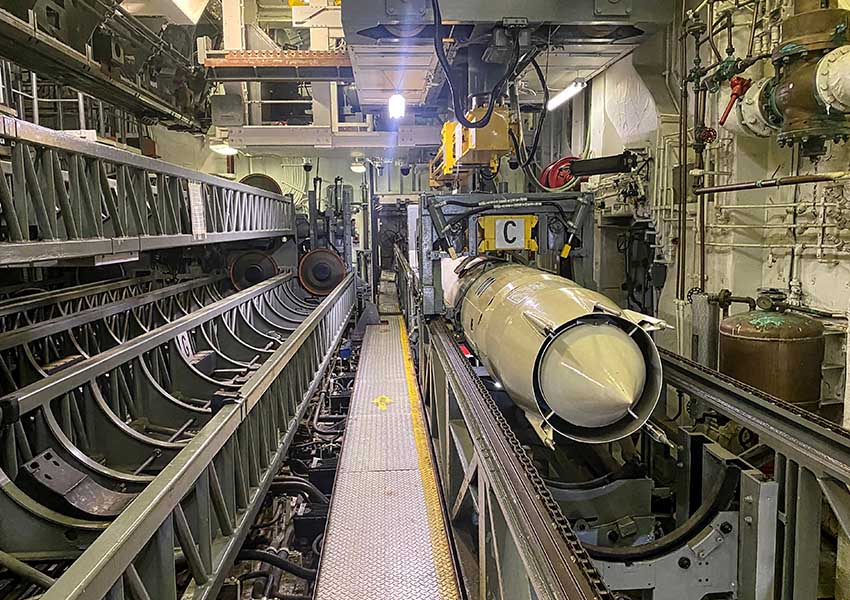


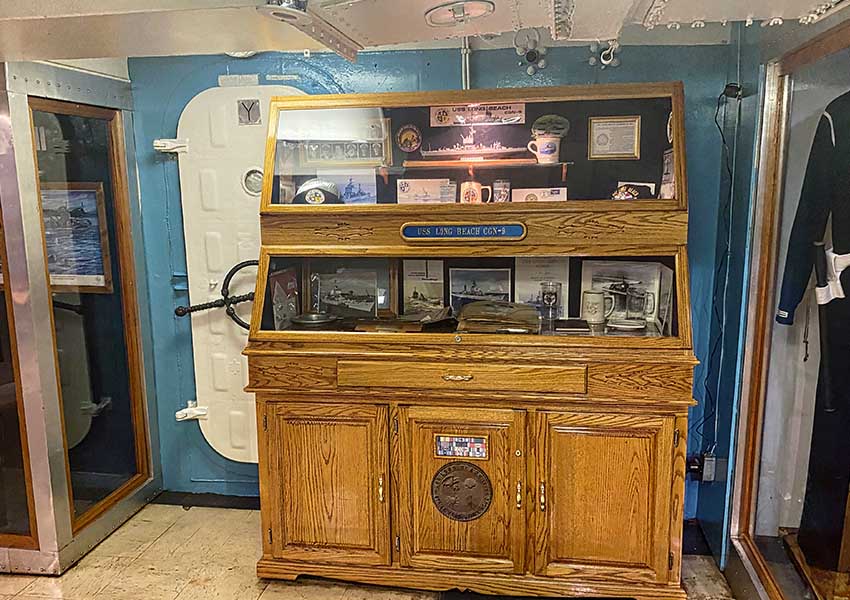
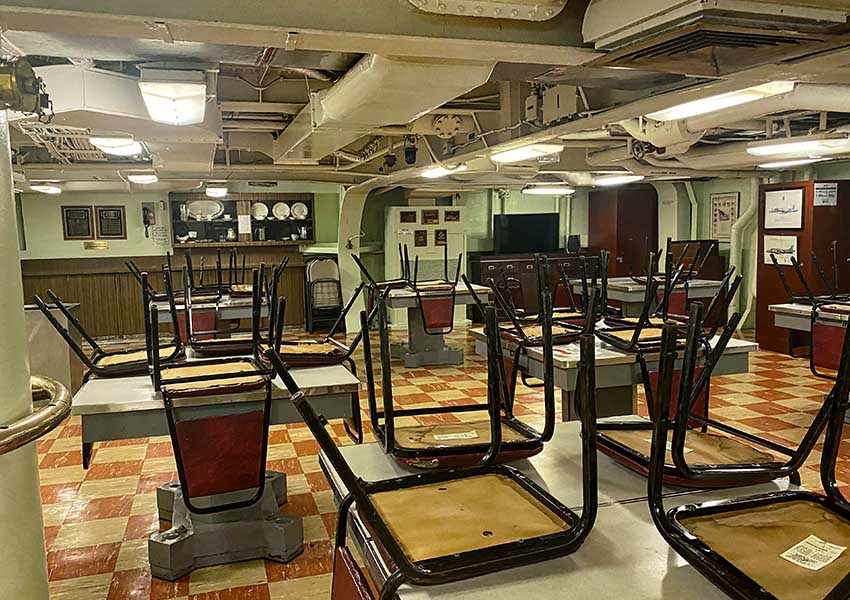
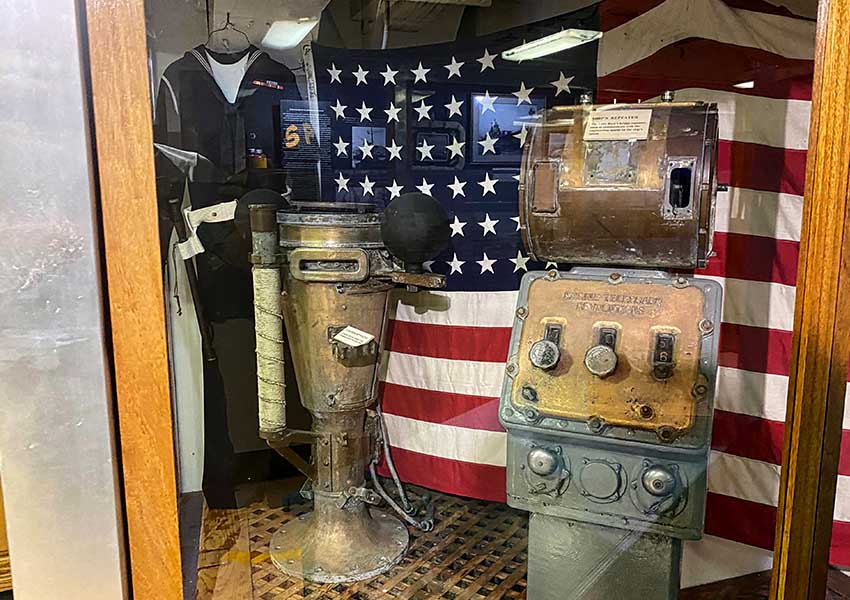
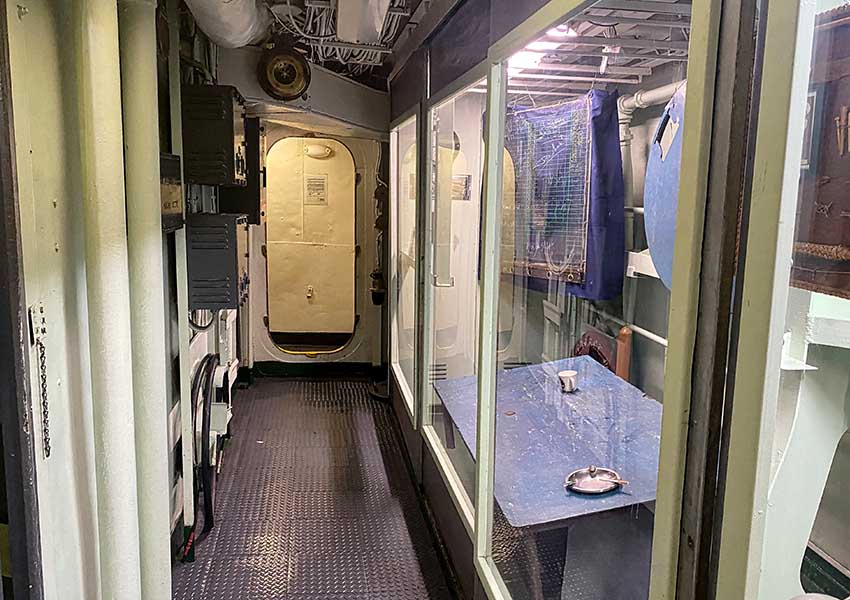
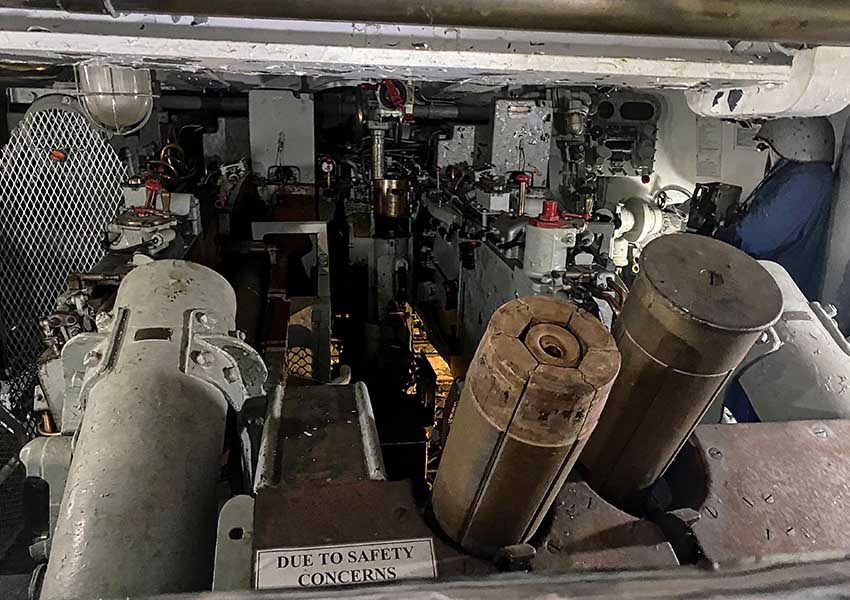
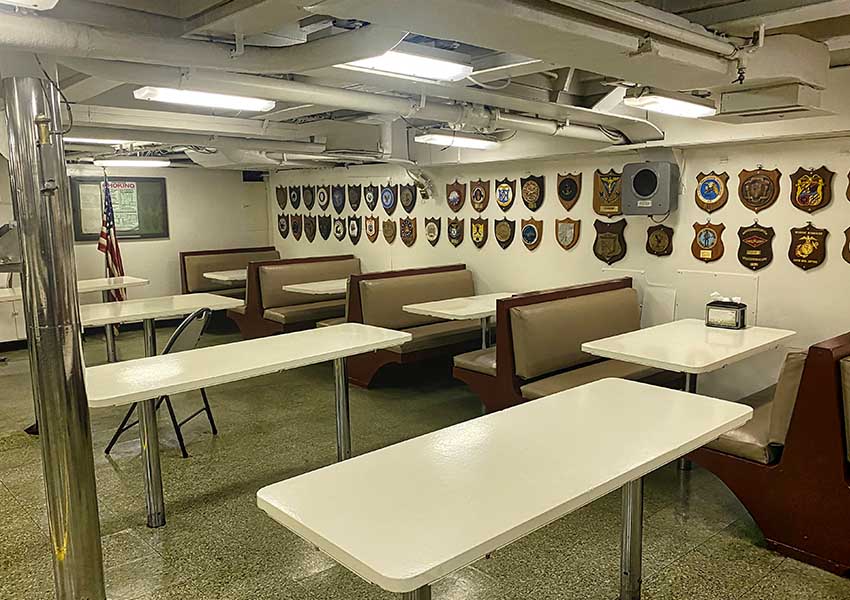
DESCRIPTION
The Cleveland Cruisers were described in a Navel Legends YouTube presentation as being the unsung workhorses of every major sea battle in the Pacific Theater. They had state-of-the-art equipment and technical savvy for the time, lighter tonnage, and hulls hard to get through and even harder to sink.
The Cleveland Cruisers could go at a clip of up to 32.6 knots, and had a serious collection of anti-aircraft guns on the main deck as well as weapons to hit enemy ships with. They became the Pit Bulls of the planned Naval defense of the aircraft carriers, a formidable force of defense for any Navy aircraft carrier it was assigned to protect
The USS Cleveland Cruiser Little Rock started out with all the weapons mentioned above in its arsenal. It wound up carrying missiles as it was transformed to be a modernized cruiser for use in the 1960s and 70s before being retired and made open to the public. It was the only one of the Cleveland Cruisers turned missile carrier to survive intact.
Tom and I got to step aboard the USS Little Rock when we visited The Buffalo and Erie County Naval & Military Park, in Buffalo, New York. Wow! On the deck, most of the defense guns were gone and replaced with missile launchers as this was done when it was re-equipped to become a Galveston Cruiser to serve in the modern 20th Century.
While I personally didn’t like the steep, narrow steps meant for younger people, they were worth facing to see all the areas of this ship that worked together with a capable, dedicated, brave crew in control. We visited crew and officer quarters, and all the living areas in this mini-city. Works areas were also well preserved with interesting exhibits.
HISTORY
The Cleveland Cruisers
Traditionally, the purpose of cruisers in all eras, from sailboats to the present, has been to disrupt enemy communications, and stop supplies from reaching their destination. The ship cruisers would go north, then south then east and west on hunting expeditions in times of war.
In the late 30s, military minds decided that a light cruiser with less tonnage, but heavily armed with smaller bin 5 and 6 guns and boatloads of cannons and armaments, was the war support cruiser ship that was needed. The Cleveland Class of light cruisers was the result, formulated by military designers.
Thirty ships were ordered before 1940, and twenty seven more were ordered at the start of the war. Twenty-seven Cleveland Cruisers entered the war effort against Japan, and not one was sunk, because of the way they were built, and the skill of their crews.
The Cleveland Cruisers were indeed a valuable asset to the WW 2 war effort. The formation had the aircraft carriers in the center, with Cleveland Cruisers, then Destroyers as the layered defense system. They were tough and armed-to-the-max, and were the decisive winning force in many of the battles they fought.
What the Navy did in the Pacific was to gain a foothold on strategic islands that the Japanese had taken over. The Navy did this at Bougainville Island, biggest of the Solomon Islands, pushing the Japanese forces back to the other side of this island. The American forces now had a piece of land to stage more attacks. Not happy with this state of affairs because their foes were too close to the main Japanese Naval Center just across the bay, the Japanese staged a counter-attack to drive the Americans off the island.
The Japanese attacked in two waves, first with ships, and second with planes. The USS Cleveland Cruisers helped to sink the Japanese ships in the first wave of attack. Knowing that the planes were next, the USS aircraft carriers slipped out to sea, leaving the Cleveland Cruisers there to finish the job. In the second wave, the Japanese sent planes to drop bombs but the anti-aircraft guns kept them from doing so. Not one cruiser was touched.
The USS Cleveland Cruiser Houston’s experience during the war showed the world how tough these Cruisers were made and the skills of the crews. After being damaged once in battle, and taking in water, she limped off to be repaired. On the way, she was hit again, but still floated back to the repair dock despite having taken enough of a beating to sink a normal boat.
The USS Cruiser Little Rock
The Cruiser Little Rock came into existence in the Cramp Shipbuilding Company location in Philadelphia, PA. where she was “laid” on March 6th, 1943. She was one of the last Cleveland Class Light Cruisers to be completed before the end of WW2.
The USS Little Rock launched on August 27th, 1944, and commissioned for service on June 17th, 1945, emerging too late to join the WW2 battles in the Pacific Theater but was ready for duty, to be part of the big aircraft carriers entourage, supporting their missions and tours. She had all the military bells and whistles, and was armed to the teeth, and had a long career serving in the Navy.
Her first mission, after a trial cruise near the Cuban coast to see what needs to be fine-tuned on board the ship, Cruiser Little Rock was sent to South America for a five month stay. She returned to America on March 23rd, 1946, docking at Norfolk, VA, but not for long. She participated in exercises off the East coast for two months, before joining the 6th Fleet for a summer tour in Europe.
From November 21-27, 1946, she was assigned along with USS Fechteler (DD-870) to be the escort group for the USS Missouri (BB-63)which was on the way to be part of Task Group 20.2 in the Davis Strait.
During cold weather exercises, The USS Little Rock had a deadly malfunction, a problem that wasn’t apparent during their trial cruise. While participating in a Task Group 20.2 exercise between Greenland and Baffin Island, her role was to provide illumination off the port side of the USS Missouri, by pointing her 5 point shell guns down at the water.
Unfortunately, the round “cooked off” (thermally induced firing), hitting the signal bridge of the USS Missouri, killing sailer Coxswain Robert Fountain instantly, and starting a fire.
In 1949, The USS Little Rock was decommissioned and became part of the Atlantic Reserve Fleet in New York for 8 years until May 23rd, 1957. Being one of six Cleveland Cruisers chosen, she was reclassified as a CLG-4 and began to be converted into a Galveston class guided missile light cruiser. Her aft six-inch turrets were replaced with a Talos Missle Battery. She once again was a state-of-the-art ship, ready to be part of the active Navy.
After being recommissioned on June 3rd, 1960, she went on a trial cruise in the Caribbean, which included testing and firing her Talos missiles. Capt. J.O. Phillips was in command.
She joined the Sixth Fleet in February of 1961, in her new role, and was deployed to Europe and after that to many other places of unrest as a stabilizing force. In 1967, she replaced
the USS Springfield as the Sixth Fleet Flagship, and sailed to her new homeport at Gaeta, Italy.
During 1967, Six Day War conflict between Israel and her hostile neighbors, The USS Little Rock sprang into action and made a bee-line to the eastern Mediterranean, acting as the N.A.T.O. command ship.
When the USS Liberty was mistakenly attacked by Israeli planes, The USS Little Rock was there to give medical aid to the injured and comfort to the dying.
In the spring of 1976, all the UC Navy Talos SAM systems were deactivated, not to be used anymore. Plans were made to refit and modernize the USS Little Rock, until it was discovered that her propulsion system required extensive repairs. She was decommissioned in the Fall of 1976.
The USS Little Rock was towed up the Saint Lawrence Seaway to Buffalo, New York to be a museum open to the public.
HISTORY OF MANIFESTATIONS
When people suffer a traumatizing or unexpected death while serving in the Navy, they sometimes choose to stay where they were stationed in order to find some peace while trying to work through what happened to them. This especially happens with war casualties and accidents.
USS Livingston, TX (The USS Livingston was hit by a kamikaze pilot that set the ship deck and engine room on fire, burning to death sailors caught in fire storm. Spirits of those men have decided to stay on board).
USS IOWA, CA (The USS IOWA suffered a huge explosion from a turret loading zone that killed the men working there).
USS Hornet (During WW2, it suffered 300 casualties from all the heavy action it saw in the Pacific war).
USS Little Rock, NY (During the Seven Day War of 1967, the USS Little Rock crew pulled from the drink badly burned survivors from the USS Liberty which had been attacked by mistake by Israelite forces. Many of these sailors died on board the USS Little Rock).
Some spirits still have a sense of duty to serve, despite lacking a physical body to do so. They see a need and step up to the plate to help, adapting to what needs to be done now.
USS Livingston, TX (The spirit of a handsome engine maintenance crewman, killed by the kamikaze pilot attack mentioned above, still reports to do his job, enjoy the pretty female visitors and even gives tours on occasion).
USS Hornet, CA (The headless spirit of a deck crewman still goes about his duties, as not having a head is no excuse not to continue in service. He was killed by a snapped landing cord).
USS IOWA (Spirits of the men killed in the 1980s’ accident have been known to keep the volunteers company, give advice and on one occasion saved a tourist’s life).
USS Little Rock, NY (A spectral security officer does inspections and keeps an eye on the visitors who come aboard).
MANIFESTATIONS
USS Liberty Casualties
After dying in USS Little Rock’s Sick Bay, some have decided to serve on this ship.
In their mind’s eye, they continue to work in their old duty stations they had been trained for, and perhaps expand their duties to be helpful.
They have become the spectral crew, with good attitudes and a high work ethic.
Auditory and Tactile Cues of Unseen Presences
Clear, disembodied voices have been heard and recorded on the main deck area.
Visitors can feel unseen presences checking them out.
Footsteps can be heard following the living, to be noticed by the folks in the same area.
Spirit of Security Officer
This spirit is an enthusiastic spectral volunteer who checks bags brought on board by folks spending the night or who are part of a paranormal investigation group.
People who are within earshot but not in the same room as their belongings, have heard their bags being unzipped, someone rummaging around in their bags and then zipped again.
The Living have heard footsteps behind them, following them around as they perhaps were deemed to be suspicious and needed to be carefully watched.
This spirit may also be the one who inspects bags on board the Croaker, only a gangplank with guard rails away as all three vessels: The Croaker, The USS Little Rock and the USS The Sulivans are all connected for the convenience of visitors who bought tickets to see all three.
Personal Appearances
The living have seen shadows of spirits, and apparitions moving about the vessel going about their business.
Some of these apparitions and shadow people may be USS Liberty casualties or past crew members of the USS Little Rock, who have chosen to stay on the ship they loved in their afterlife.
Unexplained light orbs have been seen hovering over the ship’s bridge.
Spirit of Lonely Sailor
This spirit, probably a USS Liberty casualty, or perhaps the receiver of a Dear John letter, really misses his family and his beloved.
He follows women around the ship, hoping for recognition and attention, trying to find peace this way.
He may touch them in a loving way, and may even make an appearance when so inspired.
The fact that he has been identified as a lonely, love-lorn sailor, must mean that he has let the living know what is bothering him through direct contact, auditory cues or through EVPs.
He may be the spirit who follows women into The Croaker where he can get close enough to touch them more easily.
PARNORMAL FINDINGS
Spirits still serving aboard The USS Little Rock are not shy about being seen or heard, as they are very much interested in serving and doing their duties. It is not surprising that the volunteers, guests to events held on board, visitors touring the ship, people spending the night and paranormal investigators have all had personal experiences here with the spirits.
Quite a few paranormal investigators have caught EVPs, heard the auditory claims and on occasion have seen a shadow person or apparition. Ghost Hunters (TAPs) came to investigate, as did Visual Paranormal, along with many more groups. Most paranormal groups have caught some activity.
STILL HAUNTED?
A Big Yes Indeed!
Spirits for a variety of reasons decided to spend their afterlife aboard the USS Little Rock because they loved their service here, were rescued and made comfortable before they died of their wounds, or loved this part of their life, and want to continue here in spirit form.
John Branning, retired Naval Senior Chief and now the superintendent of the Buffalo Naval Park in 2014, states in a WiVB.com article by Evan Anstey, “It’s just former crew members. We’re all ship mates. They’re going about their business, I’m going about mine. They leave me alone, I leave them alone. That’s the way I look at it.”
location
The Buffalo and Erie County Naval & Military Park
1 Naval, Marina Park South
Buffalo, New York 14202
The Buffalo and Erie County Naval & Military Park is located on the shore of Lake Erie in Buffalo, New York.
SOURCES INCLUDE
- Naval Legends: Cleveland Class. USS Little Rock
Aug 3, 2016, https://www.youtube.com/watch?v=MSUsC75KU1Y - The Littoral Combat Ship Little Rock,
https://www.youtube.com/watch?v=x-LClMdA1mo - SEPT 16TH, 2016
https://www.youtube.com/watch?v=x-LClMdA1mo - https://stepoutbuffalo.com/wny-haunted-places/
- https://lite987.com/haunted-battleships-of-buffalo-cny-paranormal/
- https://www.buffalodigest.com/top-10-most-haunted-places-in-wny-2
- https://www.wivb.com/news/local-news/haunted-ships-spur-investigation-at-buffalo-naval-park/
- “Haunted” ships spur investigation at Buffalo Naval Park
by: Evan Anstey
Posted: Oct 26, 2015 / 11:24 AM EDT / Updated: Oct 26, 2015 / 11:24 AM EDT
Our Photos are copyrighted by Tom Carr
Visit the memorable… Milwaukee Haunted Hotel





































































































































